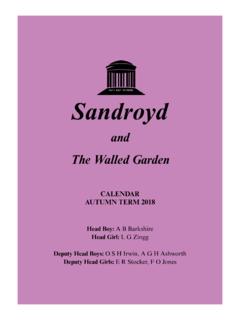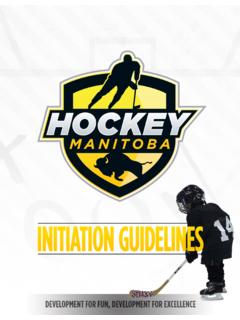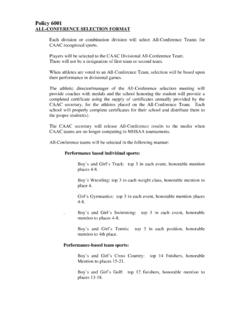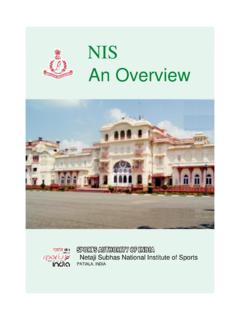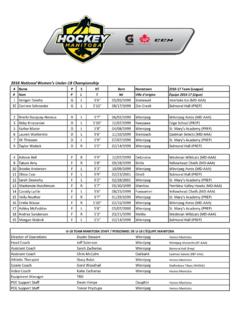Transcription of 10 Session Curriculum Guide - Pan American Hockey Federation
1 10 Session Curriculum Guidesponsored by1 Fundamental field Hockey is a youth development initiative to expose the sport to thousands of children nationwide by providing free equipment and emphasizing fun physical activity! Kids across the nation will have the opportunity to play and be exposed to field Hockey in their physical education class, at their local YMCA, or possibly in a parks and rec league. After their Fundamental field Hockey program is completed, the kids will have the option to continue to play with their local club. Our goal is to provide an avenue to play field Hockey and more importantly, have fun!Fundamental field Hockey coincides with USA field Hockey s long-term strategic plan and commitment to enhance sport development by increasing playing opportunities for boys and girls, ages 7-11. The program will emphasize fun and will involve playing small-sided games on any flat surface with a small or large group of children.
2 2 field Hockey + You = Fun3 COACHING THOUGHTS: YOU HAVE THE TOOLS, NOW WHAT? It is important that you prepare your Session according to the age-level, experience and physical ability of your players. The Curriculum is designed to be an effective Guide , not a mandatory script. You may find things that work well and others that don t. Feel free to pick and choose what works best for your program. Mix it up and keep it fresh, new and fun. It s up to Remember, each Session is unique and you are the eyes and brains of the operation that is trying to develop a program that addresses Hockey to a wide range of ages, maturation levels, physical abilities and ability to understand such a technique based sport. If you are new to the game, study the core concepts as they are the basic fundamentals of the sport and a great Guide for teaching points. Keep it simple and safe, and you will be a huge success with your young athletes.
3 This is the first go round. Over time, the Curriculum will be improved upon, by your feedback, interaction, and your athletes excitement .SUCCESS IS UP TO YOU: It is your responsibility to bring this Curriculum to life, showing your personality, energy and enthusiasm for the sport. Your main job is to get these kids to want to continue to play. If you make the Session fun and engaging, they will fall in love with the sport and that s what this program is aiming to do. Be prepared, know the drills and how to explain them quickly! Your smooth and efficient transition between one drill to the next will be crucial in how successful your Session is. We understand that there will be varying levels and numbers of players you will be dealing with. Every day will present a new set of challenges. Your ability to adapt to the challenges smoothly is what makes coaching exciting. We invite you as the coach to practice the skills yourself as you will gain vital teaching experience as you participate in the FUN!
4 NOTE: Further useful information will be on our FUNdamental field Hockey Website. It is imperative that you access this site for further explanations, photo s, videos and fun games. field Hockey is a technically challenging sport to teach, especially if you don t have visual samples to watch and learn from. Once you understand the technique of any sport, teaching will be easier, as long as you keep your feedback, simple! Please visit us at box contains:24 Sticks (34 ), 24 Balls, 12 cones and a 10- Session Curriculum Guide (Review prior to each Session ) 4n DO NOT allow swinging of sticks at any time! Stop the play with your whistle and explain to everyone that when tackling or battling for the ball, you must keep the stick in contact with the ball. NO SWINGING! Show what is acceptable and what is not!n Warm-up with a fun game and make sure kids cool down and stretch after every Always check the weather conditions prior to leaving for the Session !
5 N Check the grounds upon arrival for potential Outdoor field : broken glass (remove carefully), holes in field (fill), any obstacles that players could run into (move), are there other players playing close to your field (flying balls, obstacles) and weather (know what to do and where to go in case of lightning or torrential downpour)n Indoor Facility: make sure any obstacles (extra cones, water bottles and clothing are removed from playing area). Also, too many electrical cords in a nearby outlet could create a health hazard. If you have any extra requirements of your facilities, ensure they are catered for by a suitable Tennis court: if nets are removed, place cones near the poles and make sure drills are safely away from area. If a ball travels near the poles, be sure to have a method to stop the play ( stop or whistle the play dead )n Know where the first-aid kit is and how to get help if there is an Record the medical history of your athletes.
6 Make sure you know which ones have a health issue or prior injury you need to be aware of. Ensure you have emergency contact details of parents / caregivers / family. n If necessary, match the athletes physical skills and abilities to provide balanced competition. Safety is #1 Preparing for your session5n We are not trainers, we are teachers. Organize your Session with this in mind. n Create a STOP Signal for your players that is consistent throughout each Session . On your STOP signal, all players stop what they are doing and make eye contact with you to await further direction. Example, ! n Create a GO Signal for your players that is also consistent throughout each Session . This establishes a routine to keep order and allow for smooth transitions. Example, ! n Show by your body language and voice inflection, that you are excited, when someone tries something you ve taught, and be specific as to why.
7 Ask a question, Excellent reception, Matt. Why do you think it was so successful? A reply might be, because I had my stick on the ground? Teacher replies, Yes, Now, let s set a goal to get 3 in a row, okay? n For 7-11 year olds, fun hidden learning games that teach the basics will be key. Feel free to think of fun games that can be used with stick and ball. n Develop Feedback Strategies. Feedback should be timely. You can be corrective but be it fun and enjoyable for the players to give and receive feedback. Gain trust between you and each player. n Provide high rates of instructional and motivational feedback. Ensure positive student interactions outnumber corrective ones. n Challenge them through competition (small games / skill rep s under time pressure and repetition (simple patterns)n Be prepared for every scenario. Brainstorm what could happen and sort out a calm solution.)
8 Examples: Environmental (weather), kids (late), someone gets injured and you are the only coach at the site, etc. n Establish a system of helpers to set up and put away Be line conscious! Be aware of how long children are having to wait for their turn. Divide students into smaller groups, use more equipment, set up activity / drill stations. THE ART OF COACHINGSome Simple Coaching Philosophy, by Terry Walsh USA Technical Director for USA field Hockey Coaching is about asking questions, and listening 6areBasic Rules, Proper Grips & Posture, Ball & Stick Control, Tackling, Receiving/Trapping, Passing, and Fun CORE CONCEPTS are the skillsyou will be teaching to the kids during the Session . Not ALL technical feedback needs to be given in too much may pick and choose a couple of the points, after players have tried them. CORe CoNcepTCORe CoNcepTs7 EXAMPLE: Sample Curriculum GOALS: Keep it the kids playing as quickly as possible!
9 We must make it fun first and teach second. If done right you can do both at the same Session Objectives: Introduce a skill and a rule or two each day and revisit the following them up and play by the end of each are only an hour as time goes by them involved in a drill/competition & correct skills on the spot. Between drills, we address the class with a quick skill correction something that you see most of them doing wrong. A quick demo of that correction and on to the next fun drill usually works prepared and flexible to adjust your Session according to the make-up/experience of your Breakdown: The Ways of the Wise Start the first class with the grip of the stick, turning the stick in your hand and the flat side rule. I feel this is the most needed skill and hardest for players to develop. We start with this at the beginning of every practice. Show them a technique and let them immediately practice it.
10 Too much feedback will kill the fun! Make verbal corrections as they practice (players who are doing it correctly, use as examples). Keep the kids busy but on task with the skill. Practice a skill then put them in a drill/challenge with that skill. Use fun games that develop footwork and stick skillsI always finish the Session with a real game. A Warning: The problem I am running into is the individual player s skill levels are becoming more and more separated. Players who are younger or develop slower are intimidated by the players who are aggressive and catching on faster. This gets tricky if you don t have a way to divide them or if you have a large age difference in your group. We hold advanced and beginner classes to adjust. Having extra coaches can also help, but may not be accessible at all #1 Curriculum Tip: The sooner they start playing the faster they get the hang of the sport. I am very relaxed on the rules at first, but each week I start to call more and more is important to have the coaches participate if possible to keeping the ball distributed more which speeds up the game and promotes player involvement.
